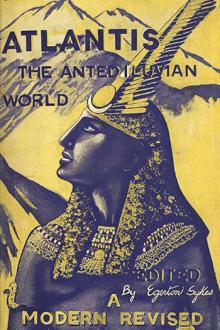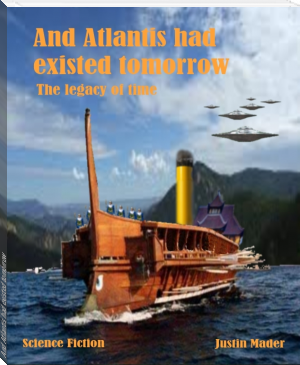Atlantis: The Antedeluvian World by Ignatius Donnelly (thriller novels to read .TXT) 📕

- Author: Ignatius Donnelly
- Performer: -
Book online «Atlantis: The Antedeluvian World by Ignatius Donnelly (thriller novels to read .TXT) 📕». Author Ignatius Donnelly
Not only do we find the same receding forehead in the skulls of the ancient races of Europe and America, and the same attempt to imitate this natural and peculiar conformation by artificial flattening of the head, but it has been found (see Henry Gillman’s “Ancient Man in Michigan,” “Smithsonian Report,” 1875, p. 242) that the Mound Builders and Peruvians of America, and the Neolithic people of France and the Canary Islands, had alike an extraordinary custom of boring a circular bole in the top of the skulls of their dead, so that the soul might readily pass in and out. More than this, it has been found that in all these ancient populations the skeletons exhibit a remarkable degree of platicnemism, or flattening of the tibiæ or leg bones. (Ibid., 1873, p.367.) In this respect the Mound Builders of Michigan were identical with the man of Cro Magnon and the ancient inhabitants of Wales.
The annexed ancient Egyptian heads, copied from the monuments, indicate either that the people of the Nile deformed their beads by pressure upon the front of the skull, or that
EGYPTIAN HEADS.there was some race characteristic which gave this appearance to their heads. These heads are all the heads of priests, and therefore represented the aristocratic class.
The first illustration below is taken from a stucco relief found in a temple at Palenque, Central America. The second is from an Egyptian monument of the time of Rameses IV.
The outline drawing on the following page shows the form of the skull of the royal Inca line: the receding forehead here seems to be natural, and not the result of artificial compression.
Both illustrations at the bottom of the preceding page show the same receding form of the forehead, due to either artificial deformation of the skull or to a common race characteristic.
We must add the fact that the extraordinary practice of deforming the skull was found all over Europe and America to the catalogue of other proofs that the people of both continents were originally united in blood and race. With the couvade, the practice of circumcision, unity of religious beliefs and customs, folk-lore, and alphabetical signs, language and flood legends, we array together a mass of unanswerable proofs of prehistoric identity of race.
PART IV.
THE MYTHOLOGIES OF THE OLD WORLD A RECOLLECTION OF ATLANTIS.
CHAPTER I. TRADITIONS OF ATLANTIS.
We find allusions to the Atlanteans in the most ancient traditions of many different races.
The great antediluvian king of the Mussulman was Shedd-Ad-Ben-Ad, or Shed-Ad, the son of Ad, or Atlantis.
Among the Arabians the first inhabitants of that country are known as the Adites, from their progenitor, who is called Ad, the grandson of Ham. These Adites were probably the people of Atlantis or Ad-lantis.
“They are personified by a monarch to whom everything is ascribed, and to whom is assigned several centuries of life.” (“Ancient History of the East,” Lenormant and Chevallier, vol. ii., p. 295.), Ad came from the northeast. “He married a thousand wives, had four thousand sons, and lived twelve hundred years. His descendants multiplied considerably.
After his death his sons Shadid and Shedad reigned in succession over the Adites. In the time of the latter the people of Ad were a thousand tribes, each composed of several thousands of men. Great conquests are attributed to Shedad; he subdued, it is said, all Arabia and Irak. The migration of the Canaanites, their establishment in Syria, and the Shepherd invasion of Egypt are, by many Arab writers, attributed to an expedition of Shedad.” (Ibid., p. 296.) Shedad built a palace ornamented with superb columns, and surrounded by a magnificent garden. It was called Irem. “It was a paradise that Shedad had built in imitation of the celestial Paradise, of whose delights he had heard.” (“Ancient History of the East,” p. 296.) In other words, an ancient, sun-worshipping, powerful, and conquering race overran Arabia at the very dawn of history; they were the sons of Adlantis: their king tried to create a palace and garden of Eden like that of Atlantis.
The Adites are remembered by the Arabians as a great and civilized race.
“They are depicted as men of gigantic stature; their strength was equal to their size, and they easily moved enormous blocks of stone.” (Ibid.) They were architects and builders. They raised many monuments of their power; and hence, among the Arabs, arose the custom of calling great ruins “buildings of the Adites.” To this day the Arabs say “as old as Ad.” In the Koran allusion is made to the edifices they built on “high places for vain uses;” expressions proving that their “idolatry was considered to have been tainted with Sabæism or star-worship.” (Ibid.) “In these legends,” says Lenormant, “we find traces of a wealthy nation, constructors of great buildings, with an advanced civilization, analogous to that of Chaldea, professing a religion similar to the Babylonian; a nation, in short, with whom material progress was allied to great moral depravity and obscene rites. These facts must be true and strictly historical, for they are everywhere met with among the Cushites, as among the Canaanites, their brothers by origin.”
Nor is there wanting a great catastrophe which destroys the whole Adite nation, except a very few who escape because they had renounced idolatry. A black cloud assails their country, from which proceeds a terrible hurricane (the water-spout?) which sweeps away everything.
The first Adites were followed by a second Adite race; probably the colonists who had escaped the Deluge. The centre of its power was the country of Sheba proper. This empire endured for a thousand years. The Adites are represented upon the Egyptian monuments as very much like the Egyptians themselves; in other words, they were a red or sunburnt race: their great temples were pyramidal, surmounted by buildings. (“Ancient History of the East,” p. 321.) “The Sabæans,” says Agatharchides (“De Mari Erythræo,” p. 102), “have in their houses an incredible number of vases, and utensils of all sorts, of gold and silver, beds and tripods of silver, and all the furniture of astonishing richness. Their buildings have porticos with columns sheathed with gold, or surmounted by capitals of silver. On the friezes, ornaments, and the framework of the doors they place plates of gold incrusted with precious stones.”
All this reminds one of the descriptions given by the Spaniards of the temples of the sun in Peru.
The Adites worshipped the gods of the Phœnicians under names but slightly changed; “their religion was especially solar… It was originally a religion without images, without idolatry, and without a priesthood.” (Ibid., p. 325.) They “worshipped the sun from the tops of pyramids.” (Ibid.) They believed in the immortality of the soul.
In all these things we see resemblances to the Atlanteans.
The great Ethiopian or Cushite Empire, which in the earliest ages prevailed, as Mr. Rawlinson says, “from the Caucasus to the Indian Ocean, from the shores of the Mediterranean to the mouth of the Ganges,”
was the empire of Dionysos, the empire of “Ad,” the empire of Atlantis.
El Eldrisi called the language spoken to this day by the Arabs of Mahrah, in Eastern Arabia, “the language of the people of Ad,” and Dr.
J. H. Carter, in the Bombay Journal of July, 1847, says, “It is the softest and sweetest language I have ever heard.” It would be interesting to compare this primitive tongue with the languages of Central America.
The god Thoth of the Egyptians, who was the god of a foreign country, and who invented letters, was called At-hothes.
We turn now to another ancient race, the Indo-European family—the Aryan race.
In Sanscrit Adim, means first. Among the Hindoos the first man was Ad-ima, his wife was Heva. They dwelt upon an island, said to be Ceylon; they left the island and reached the main-land, when, by a great convulsion of nature, their communication with the parent land was forever cut off. (See “Bible in India.”) Here we seem to have a recollection of the destruction of Atlantis.
Mr. Bryant says, “Ad and Ada signify the first.” The Persians called the first man “Ad-amah.” “Adon” was one of the names of the Supreme God of the Phœnicians; from it was derived the name of the Greek god “Ad-onis.”
The Arv-ad of Genesis was the Ar-Ad of the Cushites; it is now known as Ru-Ad. It is a series of connected cities twelve miles in length, along the coast, full of the most massive and gigantic ruins.
Sir William Jones gives the tradition of the Persians as to the earliest ages. He says: “Moshan assures us that in the opinion of the best informed Persians the first monarch of Iran, and of the whole earth, was Mashab-Ad; that he received from the Creator, and promulgated among men a sacred book, in a heavenly language, to which the Mussulman author gives the Arabic title of ‘Desatir,’ or ‘Regulations.’ Mashab-Ad was, in the opinion of the ancient Persians, the person left at the end of the last great cycle, and consequently the father of the present world. He and his wife having survived the former cycle, were blessed with a numerous progeny; he planted gardens, invented ornaments, forged weapons, taught men to take the fleece from sheep and make clothing; he built cities, constructed palaces, fortified towns, and introduced arts and commerce.”
We have already seen that the primal gods of this people are identical with the gods of the Greek mythology, and were originally kings of Atlantis. But it seems that these ancient divinities are grouped together as “the Aditya;” and in this name “Ad-itya” we find a strong likeness to the Semitic “Adites,” and another reminiscence of Atlantis, or Adlantis. In corroboration of this view we find, 1. The gods who are grouped together as the Aditya are the most ancient in the Hindoo mythology.
2. They are all gods of light, or solar gods. (Whitney’s Oriental and Linguistic Studies,” p. 39.)
3. There are twelve of them. (Ibid.)
4. These twelve gods presided over twelve months in the year.
5. They are a dim recollection of a very remote past. Says Whitney, “It seems as if here was an attempt on the part of the Indian religion to take a new development in a moral direction, which a change in the character and circumstances of the people has caused to fail in the midst, and fall back again into forgetfulness, while yet half finished and indistinct.” (Ibid.)
6. These gods are called “the sons of Aditi,” just as in the Bible we have allusions to “the sons of Adab,” who were the first metallurgists and musicians. “Aditi is not a goddess. She is addressed as a queen’s daughter, she of fair children.”
7. The Aditya “are elevated above all imperfections; they do not sleep or wink.” The Greeks represented their gods as equally wakeful and omniscient. “Their character is all truth; they hate and punish guilt.”
We have seen the same traits ascribed by the Greeks to the Atlantean kings.
8. The sun is sometimes addressed as an Aditya.
9. Among the Aditya is Varuna, the





Comments (0)